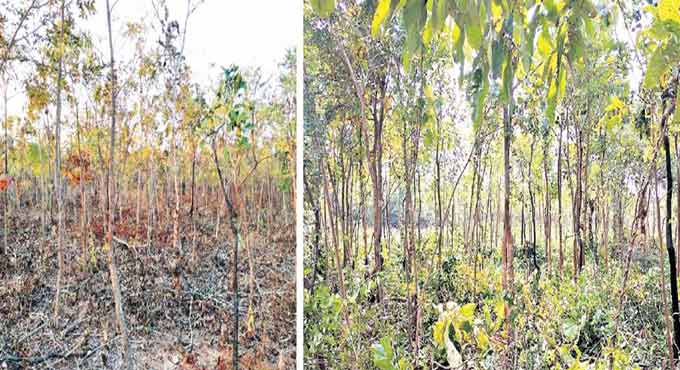Mulugu: With concerted efforts by the forest department, the degenerated tracts and blocks in forest areas of Mulugu are all set to turn greener. Thanks to a forest rejuvenation method known as the Assisted Natural Regeneration (ANR), a total of 5,834 hectares will soon have more trees.
The ANR, a low cost forest restoration method that can effectively convert deforested lands of degraded vegetation to more productive forests, aims at accelerating rather than replace natural successional processes by removing or reducing barriers to natural forest regeneration such as soil degradation, competition with weedy species and recurring disturbances. The ANR was implemented under Venkatapuram, Tadwai and Mulugu divisions in the district at a total cost of Rs 3.33 crore in 2019-20 and 2020-21.
The forest department is also trying to improve green cover by checking illegal Podu cultivation, and is planning to take up plantation in forest lands that were allegedly cleared by Gotti Koyas or Gothi Koyas, who migrated to Eturnagaram forest area from Chattisgarh.
The total forest area in the district is 2.94 lakh hectares, and the Eturunagaram Wildlife Sanctuary lies in this forest area. The sanctuary has southern tropical dry deciduous type of teak and its associates like Thiruman, Maddi, and bamboo, Madhuca, Terminalia and Pterocarpus. It is home to Tiger, Leopard, Wolf, Dholes, Golden jackals, Sloth bear, Chousingha, Blackbuck, Nilgai, Sambar, Spotted deer, Chinkara, Indian giant squirrels and many kinds of birds.
Speaking to Telangana Today, District Forest Officer (DFO) Pradeep Kumar Shetty said that they were taking several measures to protect the forest in the district including rejuvenation using the ANR method. “We are also taking steps to prevent the forest fires during the summer. Quick response teams with five special members have been deployed in each forest area to be on constant alert for fire hazards. As soon as they receive information based on the satellite, the crew reach will reach the area and extinguish the fire,” he said and warned that stringent action would be taken if anyone set fire to the forest.
“On the other hand, we are also taking steps to curb illegal felling of trees, smuggling of timber, wildlife and sand smuggling in the forest area. We have increased the surveillance by setting more camera traps. We are also constructing check dams and percolation tanks in the forest area for the benefit of the wildlife,” Shetty said. Chief Conservator of Forests (CCF), Warangal range, MJ Akbar has also recently inspected the percolation tank works under Bhupathipur Beat, Gurrevula Beat and Kannayigudem forest areas under Eturunagaram Range. He suggested setting up a watchtower for the use of base camp personnel as they have to monitor the movement of wildlife from time to time.
Meanwhile, forest officials are also keeping a close watch on movement of tiger after a big cat was spotted in the forest areas of Kannaigudem mandal under Eturnagaram wildlife sanctuary in October last year. While a tiger was spotted near Azamnagar village Bhupalpally mandal in neighbouring Jayashankar Bhupalpally district in August 2020 after more than a decade, it is said that a tiger with a cub was actually spotted in Kannaigudem forest area before it was spotted near Azam Nagar of Bhupalpally district. Considering this, and some other aspects, the forest department is trying to convince the Union government to declare a ‘Tiger Reserve’ in erstwhile Warangal district.
Now you can get handpicked stories from Telangana Today on Telegram everyday. Click the link to subscribe.
Click to follow Telangana Today Facebook page and Twitter .
